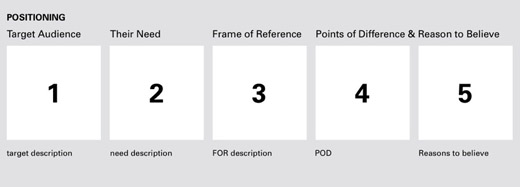As noted in the post Positioning – Much Abused. How to Use here at Distility Branding, for 1day1brand, we use the classic positioning statement that is made up of the elements in the above diagram.
1.Your Target Customer
2.Their Need
3.Their Frame of Reference
4.Your Dramatic Difference(s)
5.Your reason(s) to believe
Together they give us a positioning statement such as the one I’ve intuited for the Motorola Droid:
For the technology leader who needs the latest and greatest device, the Motorola Droid is the iphone killer, with a giant screen and the ability to run multiple applications with ease.
This week, I’d like to breakdown the statement components, starting with…
The customer
Of course it all starts with getting the customer right! And this is where all too often it goes wrong, especially in B2B branding, where targeting a job title is very helpful.
Can You Describe the Customer?
Ask yourself, “How well does your firm know the customer?”
Can your team describe the customer clearly with a good sense of their age, education, aspirations and pains? Can you easily find real examples of your “typical” customer? You may not have the budget of Motorola, but that doesn’t excuse your team from doing their homework.
Does the Customer Have a Pain or Desire you Resolve?
Although the target customer’s pain or desire is not explicitly mentioned in the positioning statement, it is very important that it exist. A customer that has no pain or desire for your solution is the wrong customer. A vegan is not a good target customer for a brand that is made out of meat. In the case of the Motorola Droid, they know that iphone super-users can be pained by the lack of multi-tasking. They know that while it isn’t a pain, a larger screen is something they desire.
Are you really sure?
Ask your team: “Have we missed the blindingly obvious?” For instance, if you are developing a solution for routine laboratory analysis, is the primary target audience the laboratory technician who uses the solution? Or is it the laboratory manager who makes the buying decision? If you aren’t sure, you must figure it out before you do any further branding.
What about Motorola? They have targeted a tiny market – disaffected iPhone users. Why wouldn’t they copy Apple? After all, when Apple introduced the iPhone, they originally took great pains to sell it as a… phone. Apple didn’t want to scare people away by being technologic out the gate. But in the case of the Droid, the choice of this niche customer was conscientious and in keeping with technology marketing best practices when introducing a cutting edge device in a highly competitive market – they targeted the early-adopters, the super influencers. And since – secretly – Motorola knows it can’t kill the iPhone, it is actually trying to make the early adopters evangelists for the Droid brand, effectively pushing the desirability of Blackberry, Palm, Windows, Nokia and others down in the mind of the market.
It is key to remember that positioning must be adaptive. Unlike a brand promise or personality which should be designed to endure, positioning should change as it needs in reaction to, and anticipation of changes with the customers, competitors, and the brand’s own capabilities. Motorola will soon expand its positioning to bring more customers into the fold.

